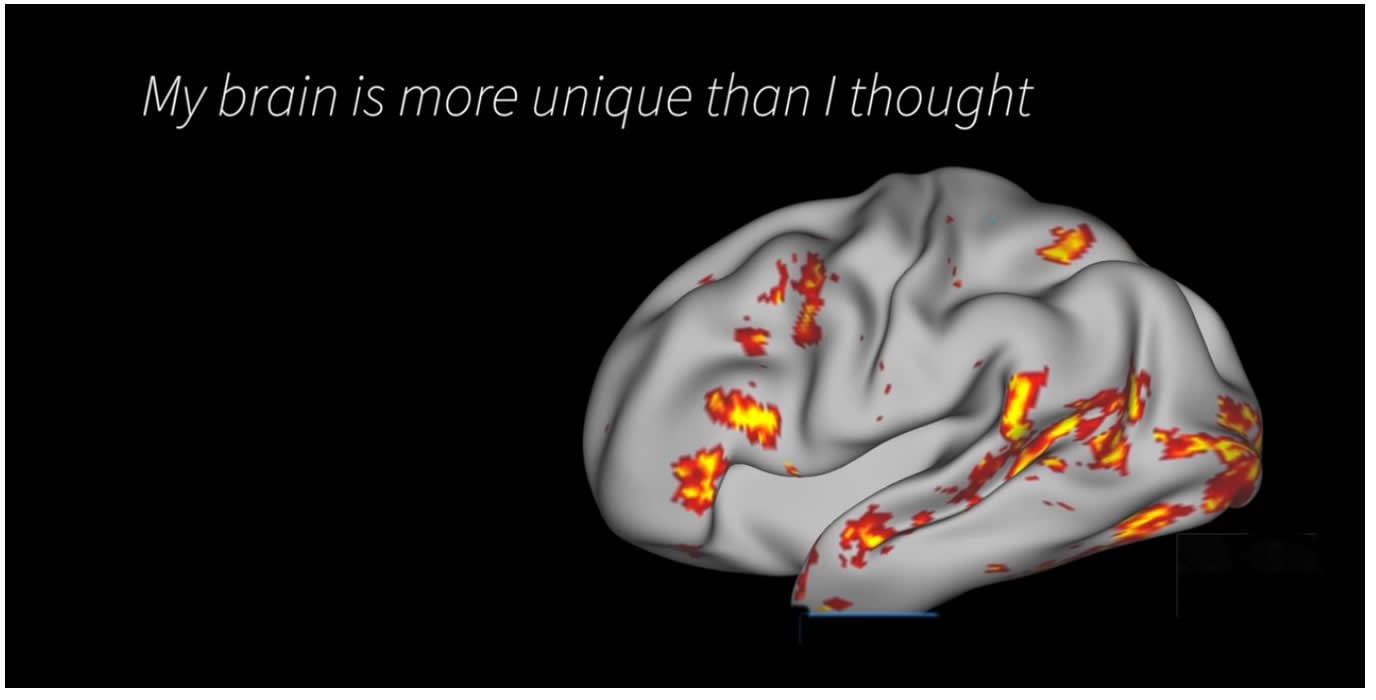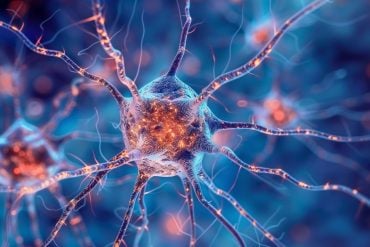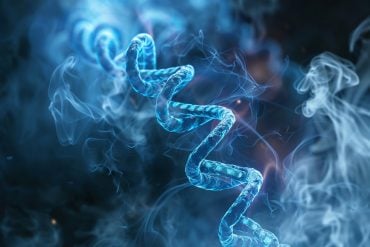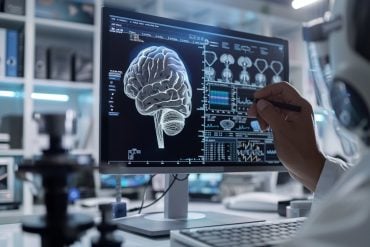Russell Poldrack scanned his brain to create the most detailed map of brain connectivity ever. In the process, he and his colleagues revealed strong correlations between brain function and gene expression, and how the brain reorganizes itself when running low on caffeine.
Every Tuesday and Thursday morning for a year and a half, Russell Poldrack started off his day by climbing into an MRI machine and scanning his brain for 10 minutes. The self-experimentation has made the Stanford psychologist’s brain the most studied in the world.
Professor Poldrack, who began the work at the University of Texas and has continued it at Stanford, committed himself to the long-term study in order to expand the understanding of how different parts of the brain talk to each other, an organization known as the connectome, and how that behavior changes over time.
To bolster the results, Poldrack also fasted and drew blood on Tuesdays, which was analyzed to draw connections between brain function and gene expression. This step also showed definitive – and surprising – evidence of just how the brain reorganizes itself when it’s low on coffee.
The results are published in Nature Communications.
Mapping brain communication
In any action that a person undertakes, many different regions of the brain communicate with each other, serving as a sort of check-and-balance system to make sure that the correct actions are taken to deal with the situation at hand. These messages are communicated over more than a dozen networks, sets of functional areas of the brain that preferentially talk to one another.
There are multiple networks for vision, a somatosensory/motor network, and there are others that are attributed to attention or task management. Collectively, these are known as the connectome. Because the strength or efficiency of these individual networks can affect behavior, they have become of greater interest to researchers in recent years.
To isolate these connections, researchers examine functional MRI data collected while the patient (including Poldrack) is at rest.
“I would get in the MRI and basically close my eyes and zone out while it took a picture of my brain every second for 10 minutes,” he said. “Once we had that data, we could get ideas of which regions of my brain are talking to each other by how correlated they are over time. This tells us how much connectivity there is within each network.”
Previously produced connectome maps have consisted of snapshots of individual brains, averaged together to identify general networks between different functional areas of the brain. Poldrack was interested in learning if these connections hold up for the same person over months.
Do they change depending on mood or other environmental influencers? And, if the connections do change, how much would his connectome look like someone else’s? Would his activity on a “sad” day look like that of a depressed person’s?
Poldrack’s connectivity was surprisingly consistent, but it did show some changes over the course of the 18 months which have never before been observed. While this result raises many new questions, the robust consistency showed that the long-term approach has promise for revealing differences between healthy brains and those of patients with neurological disorders that might suffer from disrupted connectivity, such as schizophrenia or bipolar disorder.
The coffee effect
An obvious piggyback experiment to an 18-month-long study is to examine changes in gene expression. On Tuesdays, Poldrack fasted and gave a blood sample after his scanning session. The RNA from his white blood cells was sequenced to determine his gene expression, which was then compared to his brain function.
The researchers found a strong correlation between brain activity and changes in the expression of many different families of genes. They also found that expression of genes related to inflammation and immune response matched Poldrack’s psoriasis flare-ups. Because the data set is so massive, there are still many questions to ask, which is why Poldrack is making all of the data publicly available.
Fasting for the blood draw also revealed a surprising bonus result: “Easily the biggest factor we found in terms of affecting my brain connectivity was whether I had had breakfast and caffeine or not,” Poldrack said.
On Tuesdays, when he hadn’t drunk his morning joe before the scan, the connectivity within his brain looked very different from his caffeinated brain. Anecdotally, this makes sense. But such an influence had never been observed before. In particular, the connection between the somatosensory motor network and the systems responsible for higher vision grew significantly tighter without caffeine.

“That was totally unexpected, but it shows that being caffeinated radically changes the connectivity of your brain,” Poldrack said. “We don’t really know if it’s better or worse, but it’s interesting that these are relatively low-level areas. It may well be that I’m more fatigued on those days, and that drives the brain into this state that’s focused on integrating those basic processes more.”
The signal and the noise
The results are evidence that long-term analysis is a useful tool, Poldrack said, and hopefully make it attractive to a larger population of subjects. In many ways he was an ideal subject – he was available, committed to the long haul, and could sit still in the scanner – but diversity will ultimately lead to more interesting discoveries.
“I’m generally a pretty happy and even-keeled person,” he said. “My positive mood is almost always high, and my negative mood is almost always non-existent. It would be interesting to scan people with a wider emotional variation and see how their connections look over time.”
For 18 months, Stanford psychologist Russell Poldrack scanned his brain activity twice a week to understand how functional areas of his brain communicate. Among his findings was that his brain behaves dramatically different when it craves coffee.
In the meantime, Poldrack and his colleagues have made the entire data set and the ready-built tools to analyze it available through this site: http://myconnectome.org/wp/data-sharing. The data set is so large and deep, Poldrack said, that he hopes people will approach it from innovative angles and uncover connections that will help advance the research.
Poldrack, meanwhile, plans to hone software to elucidate the interplay between brain function and gene expression.
“It’s a hard data set to know what to do with, because it’s hard to tell if something is noise or if it’s real with just one person. But there’s potentially some really interesting stuff here,” he said. “There are a ton of relationships between brain connectivity and gene expression in the blood, that are clearly there and seem to be strong, but we just don’t have a way to understand them based on current neuroscience.”
Source: Bjorn Carey – Stanford University
Image Source: The image is adapted from the Stanford video
Video Source: The video is adapted from the Stanford YouTube page
Original Research: Full open access research for “Long-term neural and physiological phenotyping of a single human” by Russell A. Poldrack, Timothy O. Laumann, Oluwasanmi Koyejo, Brenda Gregory, Ashleigh Hover, Mei-Yen Chen, Krzysztof J. Gorgolewski, Jeffrey Luci, Sung Jun Joo, Ryan L. Boyd, Scott Hunicke-Smith, Zack Booth Simpson, Thomas Caven, Vanessa Sochat, James M. Shine, Evan Gordon, Abraham Z. Snyder, Babatunde Adeyemo, Steven E. Petersen, David C. Glahn, D. Reese Mckay, Joanne E. Curran, Harald H. H. Göring, Melanie A. Carless, John Blangero, Robert Dougherty, Alexander Leemans, Daniel A. Handwerker, Laurie Frick, Edward M. Marcotte and Jeanette A. Mumford in Nature Communications. Published online December 9 2015 doi:10.1038/ncomms9885
Abstract
Long-term neural and physiological phenotyping of a single human
Psychiatric disorders are characterized by major fluctuations in psychological function over the course of weeks and months, but the dynamic characteristics of brain function over this timescale in healthy individuals are unknown. Here, as a proof of concept to address this question, we present the MyConnectome project. An intensive phenome-wide assessment of a single human was performed over a period of 18 months, including functional and structural brain connectivity using magnetic resonance imaging, psychological function and physical health, gene expression and metabolomics. A reproducible analysis workflow is provided, along with open access to the data and an online browser for results. We demonstrate dynamic changes in brain connectivity over the timescales of days to months, and relations between brain connectivity, gene expression and metabolites. This resource can serve as a testbed to study the joint dynamics of human brain and metabolic function over time, an approach that is critical for the development of precision medicine strategies for brain disorders.
“Long-term neural and physiological phenotyping of a single human” by Russell A. Poldrack, Timothy O. Laumann, Oluwasanmi Koyejo, Brenda Gregory, Ashleigh Hover, Mei-Yen Chen, Krzysztof J. Gorgolewski, Jeffrey Luci, Sung Jun Joo, Ryan L. Boyd, Scott Hunicke-Smith, Zack Booth Simpson, Thomas Caven, Vanessa Sochat, James M. Shine, Evan Gordon, Abraham Z. Snyder, Babatunde Adeyemo, Steven E. Petersen, David C. Glahn, D. Reese Mckay, Joanne E. Curran, Harald H. H. Göring, Melanie A. Carless, John Blangero, Robert Dougherty, Alexander Leemans, Daniel A. Handwerker, Laurie Frick, Edward M. Marcotte and Jeanette A. Mumford in Nature Communications. Published online December 9 2015 doi:10.1038/ncomms9885






